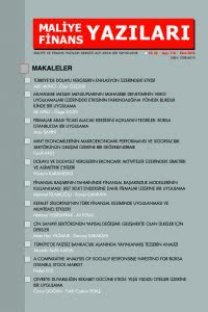Türkiye’nin Derecelendirme Notları Ve Kredi Temerrüt Swap Primlerinin Ekonomik Ve Sosyal Olaylara Tepkisinin Analizi
Kredi Temerrüt Swap Primi, Derecelendirme Notu, Çoklu Doğrusal Regresyon
ANALYSIS OF THE RESPONSES OF TURKEY’S RATINGS AND CREDIT DEFAULT SWAP SPREADS TO THE ECONOMIC AND SOCIAL EVENTS
___
- Büyüköztürk, Ş., 2012. Sosyal Bilimler İçin Veri Analizi El Kitabı, 16. Baskı, Ankara, Pegem Akademi. Castellano, R. ve R. Giacometti, 2012. Credit Default Swaps: Implied Ratings Versus Official Ones, Research Paper, 10, 163-180. Ersan, İ. ve S. Günay, 2009. “Kredi Riski Göstergesi Olarak Kredi Temerrüt Swapları (CDSs) ve Kapatma Davasının Türkiye Riski Üzerine Etkisine Dair Bir Uygulama”, Bankacılar Dergisi, 71, 3-22. Finnerty, J.D., C.D. Miller ve R.R. Chen, 2013. The Impact of Credit Rating Announcements On Credit Default Swap Spreads, 37, 2011-2030. Fitch Rating, 2014. Definitions of Ratings and Other Forms of Opinion. Flannery, M.J., J.F. Houston ve F. Partnoy, 2010. Credit Default Swap Spreads as Viable Substitutes for Credit Ratings, University of San Diego School of Law, Legal Studies Research Paper Series, No: 10-31, 2084-2123. Gande, A. ve D.C. Parsley, 2005. “News Spillovers in the Sovereign Debt Market”, Journal of Financial Economics, 75, 691-734. Hull, J., M. Predescu ve A. White, 2004. “The Relationship between Credit Default Swap Spreads, Bond Yields, and Credit Rating Announcements”, Journal of Banking & Finance, 28, 2789–2811. Ismailescu, I. ve H. Kazemi, 2010. “The Reaction of Market Credit Default Swap Spreads to Sovereign Credit Ratings Changes”, Journal of Banking and Finance, 34, 2861-2873. Jacobs, M., C.M. Peluso ve A.K. Karagözoğlu, 2010. Measuring Credit Risk: CDS Spreads vs. Credit Ratings. The 2010 FMA Meetings. Jensen, M.S. ve K.N. Daniels, 2005. “The Effect of Credit Ratings on Credit Default Swap Spreads and Credit Spreads”, The Journal of Fixed Income, 15(3), 16-33. Lehnert, T. ve F. Neske, 2006. “On the Relationship between Credit Rating Announcements and Credit Default Swap Spreads for European Reference Entities”, Journal of Credit Risk, 2, 83-90. Micu, M., E.M. Remolona ve P.D. Wooldridge, 2004. The Price Impact of Rating Announcements: Evidence from the Credit Default Swap Market, BIS Ouarterly Review, 55-66. Micu, M., E.M. Remolona ve P.D. Wooldridge, 2006. The Price Impact of Rating Announcements: Which Announcements Matter?, BIS Working Papers, No: 207. Moody’s Investor Services, 2014. Rating Symbols and Definitions. Norden, L. ve M. Weber, 2004. “Informational Efficiency of Credit Default Swap and Stock Markets: the Impact of Credit Rating Announcements”, Journal of Banking & Finance, 28, 2813-2843. Papaioannou, G., 2011. “Economic and Market Factors versus Credit Rating Announcements, on Credit Default Swap Spreads”, International Journal of Economic and Finance, 3(5), 42-48. Standard & Poor’s Rating Services, https://www.globalcreditportal.com/ratingsdirect/renderArticle.do?articleId =1019442&SctArtId=147045&from=CM&nsl_code=LIME, Erişim Tarihi: 21 Mart 2014.
- ISSN: 1308-6014
- Yayın Aralığı: Yılda 2 Sayı
- Başlangıç: 2008
- Yayıncı: Maliye ve Finans Yazıları Yayıncılık Ltd. Şti.
Borsa İstanbul’da Gün İçi Verisinin Analizi
Türk Bankacılık Sektöründe Finansal İstikrar-Rekabet İlişkisi
Banka Performanslarının Ölçümünde Risk Bazlı Uzaklık Yönlü Fonksiyon Yaklaşımı
Şaban Çelik, Deniz Erer, Elif Erer, Tuna Can Güleç
Finansal Tablo İlanlarının Hisse Getirileri Üzerindeki Etkisi: BİST’de Ampirik Bir Uygulama
İbrahim Bozkurt, Sezer Öksüz, Rıfat Karakuş
Küresel Finansal Yaptırımlar: Oyun Teorisi Yaklaşımı İle Ampirik Bir Uygulama
Finansal Kaldıraç Derecesi Ve Seçilmiş Sektörlere Yönelik Bir Uygulama
Bekir Kaya, Emine Öner Kaya, Kürşat Yalçıner
Bireysel Emeklilik Fon Tercihlerini Etkileyen Unsurlar Üzerine Bir Çalışma
